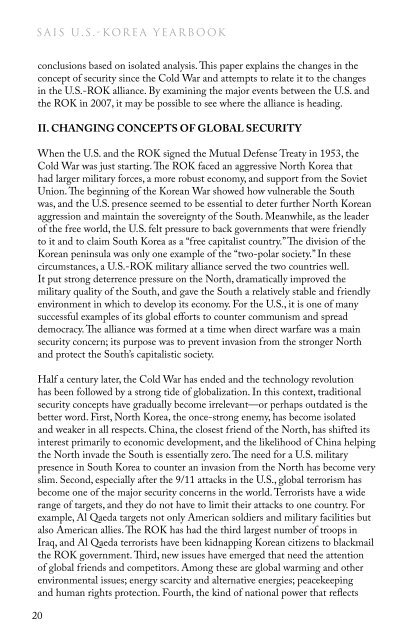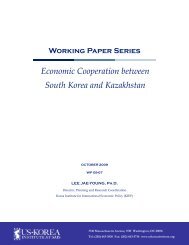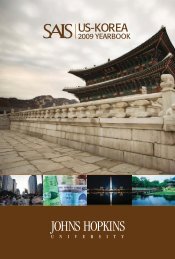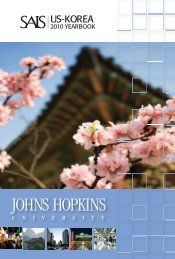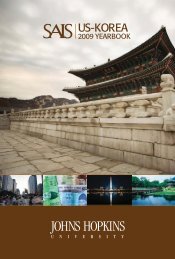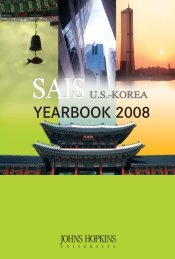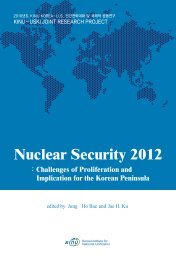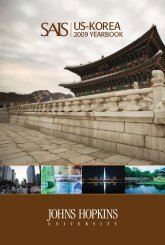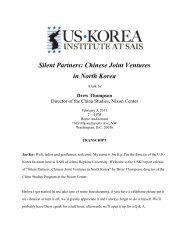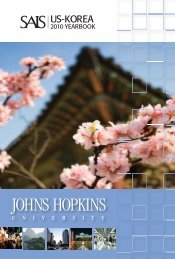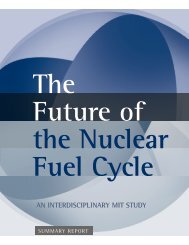YeArBooK 2007 - US-Korea Institute at SAIS
YeArBooK 2007 - US-Korea Institute at SAIS
YeArBooK 2007 - US-Korea Institute at SAIS
Create successful ePaper yourself
Turn your PDF publications into a flip-book with our unique Google optimized e-Paper software.
saIs U.s.-<strong>Korea</strong> YearbooK<br />
conclusions based on isol<strong>at</strong>ed analysis. This paper explains the changes in the<br />
concept of security since the Cold War and <strong>at</strong>tempts to rel<strong>at</strong>e it to the changes<br />
in the U.S.-ROK alliance. By examining the major events between the U.S. and<br />
the ROK in <strong>2007</strong>, it may be possible to see where the alliance is heading.<br />
20<br />
II. CHAnGInG ConCePTS of GloBAl SeCUrITY<br />
When the U.S. and the ROK signed the Mutual Defense Tre<strong>at</strong>y in 1953, the<br />
Cold War was just starting. The ROK faced an aggressive North <strong>Korea</strong> th<strong>at</strong><br />
had larger military forces, a more robust economy, and support from the Soviet<br />
Union. The beginning of the <strong>Korea</strong>n War showed how vulnerable the South<br />
was, and the U.S. presence seemed to be essential to deter further North <strong>Korea</strong>n<br />
aggression and maintain the sovereignty of the South. Meanwhile, as the leader<br />
of the free world, the U.S. felt pressure to back governments th<strong>at</strong> were friendly<br />
to it and to claim South <strong>Korea</strong> as a “free capitalist country.” The division of the<br />
<strong>Korea</strong>n peninsula was only one example of the “two-polar society.” In these<br />
circumstances, a U.S.-ROK military alliance served the two countries well.<br />
It put strong deterrence pressure on the North, dram<strong>at</strong>ically improved the<br />
military quality of the South, and gave the South a rel<strong>at</strong>ively stable and friendly<br />
environment in which to develop its economy. For the U.S., it is one of many<br />
successful examples of its global efforts to counter communism and spread<br />
democracy. The alliance was formed <strong>at</strong> a time when direct warfare was a main<br />
security concern; its purpose was to prevent invasion from the stronger North<br />
and protect the South’s capitalistic society.<br />
Half a century l<strong>at</strong>er, the Cold War has ended and the technology revolution<br />
has been followed by a strong tide of globaliz<strong>at</strong>ion. In this context, traditional<br />
security concepts have gradually become irrelevant—or perhaps outd<strong>at</strong>ed is the<br />
better word. First, North <strong>Korea</strong>, the once-strong enemy, has become isol<strong>at</strong>ed<br />
and weaker in all respects. China, the closest friend of the North, has shifted its<br />
interest primarily to economic development, and the likelihood of China helping<br />
the North invade the South is essentially zero. The need for a U.S. military<br />
presence in South <strong>Korea</strong> to counter an invasion from the North has become very<br />
slim. Second, especially after the 9/11 <strong>at</strong>tacks in the U.S., global terrorism has<br />
become one of the major security concerns in the world. Terrorists have a wide<br />
range of targets, and they do not have to limit their <strong>at</strong>tacks to one country. For<br />
example, Al Qaeda targets not only American soldiers and military facilities but<br />
also American allies. The ROK has had the third largest number of troops in<br />
Iraq, and Al Qaeda terrorists have been kidnapping <strong>Korea</strong>n citizens to blackmail<br />
the ROK government. Third, new issues have emerged th<strong>at</strong> need the <strong>at</strong>tention<br />
of global friends and competitors. Among these are global warming and other<br />
environmental issues; energy scarcity and altern<strong>at</strong>ive energies; peacekeeping<br />
and human rights protection. Fourth, the kind of n<strong>at</strong>ional power th<strong>at</strong> reflects<br />
U.s.-roK allIanCe: looKInG ToWard THe fUTUre<br />
a country’s st<strong>at</strong>us in the world and its ability to protect its security has been<br />
shifting from primarily hard power to a combin<strong>at</strong>ion of hard power and soft<br />
power. Finally, new kinds of challenges from countries other than the Soviet<br />
Union and North <strong>Korea</strong> emerged in the 21st century. For example, whether it<br />
is opportunity or challenge th<strong>at</strong> a rising China brings to the region, it definitely<br />
has changed the dynamics of regional politics and cre<strong>at</strong>ed a whole new set of<br />
policy concerns for countries in the region. Given these important changes in<br />
the concept and dynamics of security, it is essential for the U.S. and the ROK to<br />
adjust to the new situ<strong>at</strong>ion. Both sides are taking steps to address the changes.<br />
III. deVeloPMenTS In <strong>2007</strong><br />
North <strong>Korea</strong>n Nuclear Issues<br />
In <strong>2007</strong>, the U.S. and the ROK further coordin<strong>at</strong>ed their efforts to address North<br />
<strong>Korea</strong>n nuclear issues. On February 17, the Six-Party Talks moved into a new<br />
stage, after years of difficult negoti<strong>at</strong>ions and frustr<strong>at</strong>ions. The U.S. and the ROK<br />
have been learning how to deal with each other’s different security concerns in<br />
the region. There have been doubts on both sides concerning motive and str<strong>at</strong>egic<br />
approach to the North <strong>Korea</strong>n nuclear issue. In 2005 and 2006, gaps between<br />
the U.S. and the ROK were apparent. The U.S. was mostly concerned about<br />
the prolifer<strong>at</strong>ion of North <strong>Korea</strong>n nuclear m<strong>at</strong>erials, which would be especially<br />
detrimental to the U.S. if terrorist groups got their hands on them. In addition,<br />
Japan—a very important U.S. ally in the region—has been stymied in its dealings<br />
with North <strong>Korea</strong> over the abduction issue. The Japanese are more afraid of a<br />
direct <strong>at</strong>tack by North <strong>Korea</strong> than any other country in the region, so they keep<br />
pushing for a tough approach toward the North, which has contributed to the<br />
Bush administr<strong>at</strong>ion’s hard-line diplomacy toward North <strong>Korea</strong>.<br />
The hard-line approach began <strong>at</strong> the same time Kim Dae-jung was trying to<br />
approach the North with his Sunshine Policy. For the ROK, it is much more<br />
troublesome if the North becomes unstable. If economic sanctions are too harsh<br />
and the society collapses, millions of refugees could enter South <strong>Korea</strong> and cause<br />
all kinds of social and economic problems. If the hard-line policy goes too far,<br />
Seoul would be the first front in a war. And now th<strong>at</strong> the South has advanced so<br />
far economically, South <strong>Korea</strong>ns have started to feel symp<strong>at</strong>hetic to citizens in<br />
the North, who share their roots but are faced with a much harder life.<br />
For a while, the participants in the six-party talks were divided: Japan and the<br />
U.S. pushed for punitive measures, while China and South <strong>Korea</strong> were ultra<br />
cautious. Friction among the countries was apparent by the end of 2006, which<br />
caused more complaints and doubts about the alliance. The situ<strong>at</strong>ion changed,<br />
however, in <strong>2007</strong>.<br />
21


